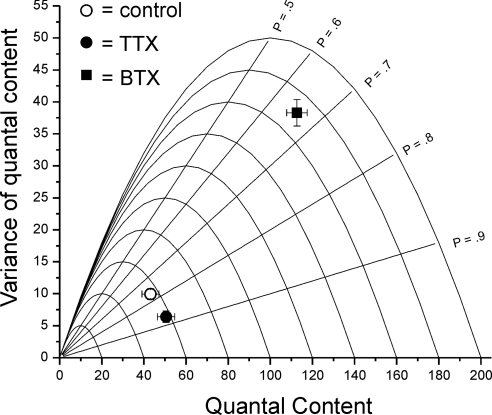Fig. 2.
Block of neuromuscular transmission by tetrodotoxin (TTX) and BTX increase quantal content by increasing p and n, respectively. Plot of the mean value of variance of quantal content vs. mean quantal content for control, TTX-blocked, and BTX-blocked endplates in solution containing 1 mM Ca. Each parabola represents the theoretical plot for a given number of releasable vesicles (n) as probability of release (p) is increased from 0 to 1.0, assuming uniform and stationary p for all releasable vesicles. Included in the plot are the parabolas from n = 20 to n = 200. Intersecting the parabolas are straight lines representing the theoretical plot for a given p as n is increased. The lines for p = 0.5 to p = 0.9 are labeled on the graph. Following block of neuromuscular transmission with a TTX cuff on the nerve, there was a statistically significant increase in probability of release (0.73 ± 0.04 in control vs. 0.85 ± 0.03 following TTX, P < 0.05), but no change in n (59.3 ± 2.9 vs. 59.1 ± 3.7). Following block of neuromuscular transmission by block of acetylcholine receptors with BTX there was a statistically significant increase in number of releasable vesicles (59.3 ± 2.9 vs. 108.1 ± 15.4, P < 0.01), but no significant change in p (0.73 ± 0.04 vs. 0.66 ± 0.03, P = 0.22). Quantal content for control was 43.1 ± 4.0; following TTX it was 50.5 ± 4.1; and after BTX it was 112.6 ± 4.9. All recordings were made in 1 mM external Ca. Number of muscles studied: control = 8, TTX cuff = 8, BTX = 5.

